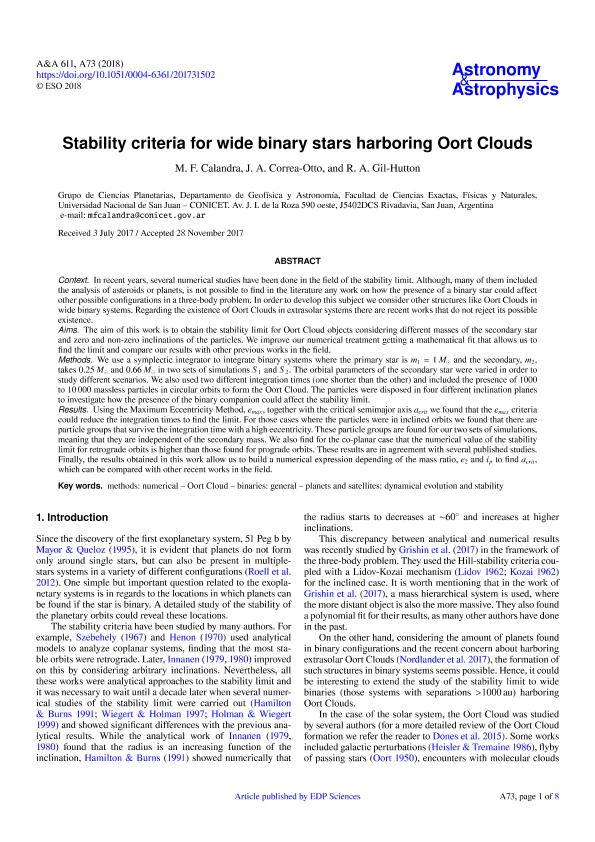Mostrar el registro sencillo del ítem
dc.contributor.author
Calandra, Maria Florencia

dc.contributor.author
Correa Otto, Jorge Alfredo

dc.contributor.author
Gil Hutton, Ricardo Alfredo

dc.date.available
2022-05-04T15:06:52Z
dc.date.issued
2018-03
dc.identifier.citation
Calandra, Maria Florencia; Correa Otto, Jorge Alfredo; Gil Hutton, Ricardo Alfredo; Stability criteria for wide binary stars harboring Oort Clouds; EDP Sciences; Astronomy and Astrophysics; 611; 3-2018; 1-8
dc.identifier.issn
0004-6361
dc.identifier.uri
http://hdl.handle.net/11336/156465
dc.description.abstract
Context. In recent years, several numerical studies have been done in the field of the stability limit. Although, many of them included the analysis of asteroids or planets, is not possible to find in the literature any work on how the presence of a binary star could affect other possible configurations in a three-body problem. In order to develop this subject we consider other structures like Oort Clouds in wide binary systems. Regarding the existence of Oort Clouds in extrasolar systems there are recent works that do not reject its possible existence.Aim. The aim of this work is to obtain the stability limit for Oort Cloud objects considering different masses of the secondary star and zero and non-zero inclinations of the particles. We improve our numerical treatment getting a mathematical fit that allows us to find the limit and compare our results with other previous works in the field.Methods. We use a symplectic integrator to integrate binary systems where the primary star is m1 = 1 M and the secondary, m2, takes 0.25 M and 0.66 M in two sets of simulations S1 and S2. The orbital parameters of the secondary star were varied in order to study different scenarios. We also used two different integration times (one shorter than the other) and included the presence of 1000 to 10 000 massless particles in circular orbits to form the Oort Cloud. The particles were disposed in four different inclination planes to investigate how the presence of the binary companion could affect the stability limit.Results. Using the Maximum Eccentricity Method, emax, together with the critical semimajor axis acrit we found that the emax criteria could reduce the integration times to find the limit. For those cases where the particles were in inclined orbits we found that there are particle groups that survive the integration time with a high eccentricity. These particle groups are found for our two sets of simulations, meaning that they are independent of the secondary mass. We also find for the co-planar case that the numerical value of the stability limit for retrograde orbits is higher than those found for prograde orbits. These results are in agreement with several published studies. Finally, the results obtained in this work allow us to build a numerical expression depending of the mass ratio, e2 and ip to find acrit, which can be compared with other recent works in the field.
dc.format
application/pdf
dc.language.iso
eng
dc.publisher
EDP Sciences

dc.rights
info:eu-repo/semantics/openAccess
dc.rights.uri
https://creativecommons.org/licenses/by/2.5/ar/
dc.subject
BINARIES: GENERAL
dc.subject
METHODS: NUMERICAL
dc.subject
OORT CLOUD
dc.subject
PLANETS AND SATELLITES: DYNAMICAL EVOLUTION AND STABILITY
dc.subject.classification
Astronomía

dc.subject.classification
Ciencias Físicas

dc.subject.classification
CIENCIAS NATURALES Y EXACTAS

dc.title
Stability criteria for wide binary stars harboring Oort Clouds
dc.type
info:eu-repo/semantics/article
dc.type
info:ar-repo/semantics/artículo
dc.type
info:eu-repo/semantics/publishedVersion
dc.date.updated
2022-05-02T16:30:07Z
dc.journal.volume
611
dc.journal.pagination
1-8
dc.journal.pais
Francia

dc.journal.ciudad
Les Ulis
dc.description.fil
Fil: Calandra, Maria Florencia. Consejo Nacional de Investigaciones Científicas y Técnicas. Centro Científico Tecnológico Conicet - San Juan; Argentina. Universidad Nacional de San Juan. Facultad de Ciencias Exactas, Físicas y Naturales. Departamento de Geofísica y Astronomía; Argentina
dc.description.fil
Fil: Correa Otto, Jorge Alfredo. Consejo Nacional de Investigaciones Científicas y Técnicas. Centro Científico Tecnológico Conicet - San Juan; Argentina. Universidad Nacional de San Juan. Facultad de Ciencias Exactas, Físicas y Naturales. Departamento de Geofísica y Astronomía; Argentina
dc.description.fil
Fil: Gil Hutton, Ricardo Alfredo. Consejo Nacional de Investigaciones Científicas y Técnicas. Centro Científico Tecnológico Conicet - San Juan; Argentina. Universidad Nacional de San Juan. Facultad de Ciencias Exactas, Físicas y Naturales. Departamento de Geofísica y Astronomía; Argentina
dc.journal.title
Astronomy and Astrophysics

dc.relation.alternativeid
info:eu-repo/semantics/altIdentifier/url/http://www.aanda.org/10.1051/0004-6361/201731502
dc.relation.alternativeid
info:eu-repo/semantics/altIdentifier/doi/http://dx.doi.org/10.1051/0004-6361/201731502
Archivos asociados
